Oman EV Market Size
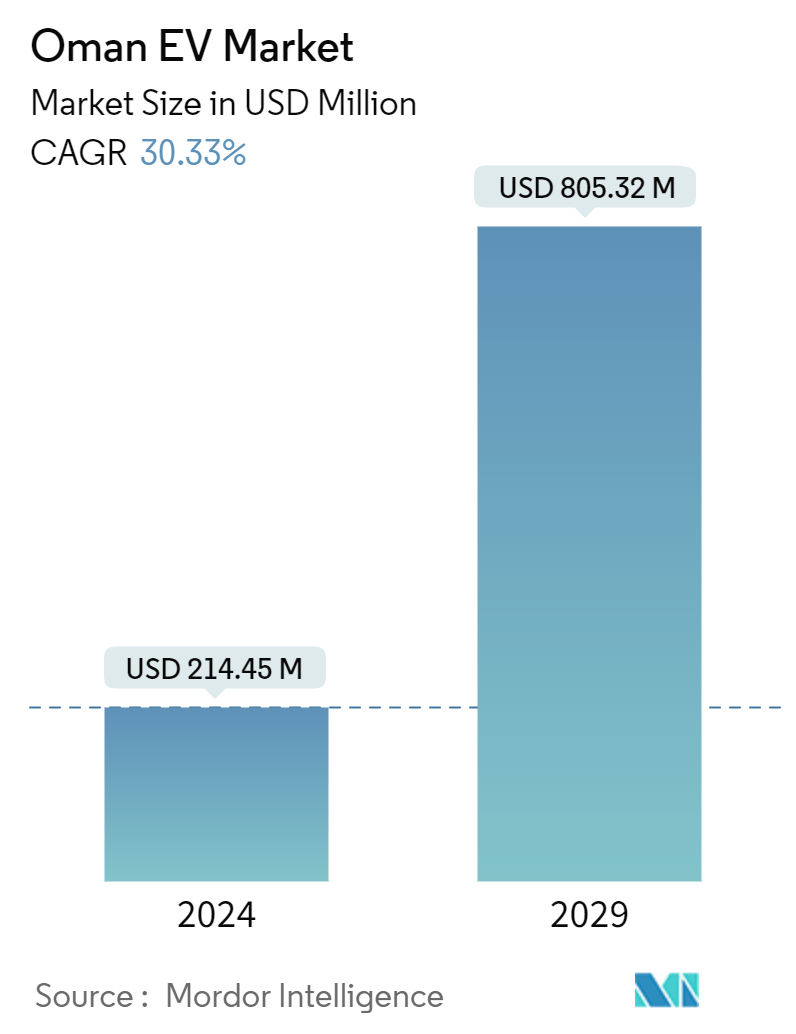
| Study Period | 2019 - 2029 |
| Base Year For Estimation | 2023 |
| Market Size (2024) | USD 214.45 Million |
| Market Size (2029) | USD 805.32 Million |
| CAGR (2024 - 2029) | 30.33 % |
| Market Concentration | Medium |
Major Players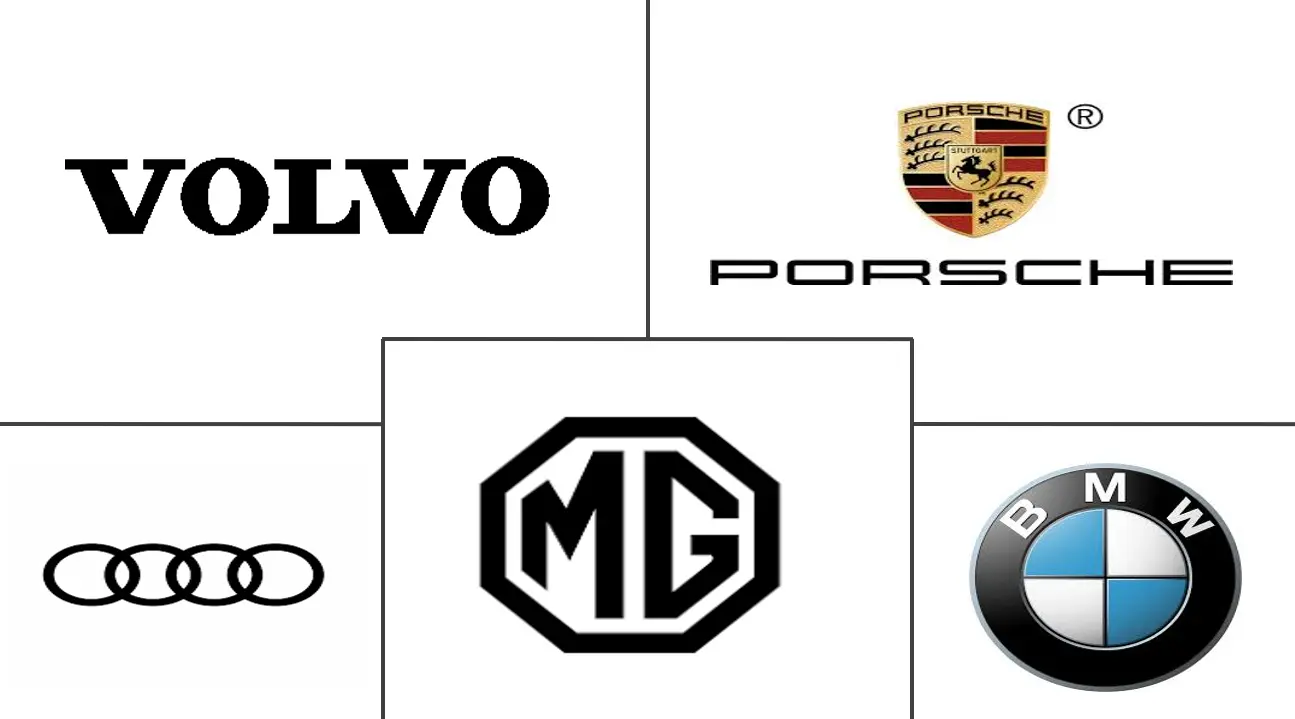
*Disclaimer: Major Players sorted in no particular order |
Oman EV Market Analysis
The Oman EV Market size is estimated at USD 214.45 million in 2024, and is expected to reach USD 805.32 million by 2029, growing at a CAGR of 30.33% during the forecast period (2024-2029).
Oman’s economy has traditionally been heavily reliant on oil and gas exports. However, in recent years, declining oil prices and the need to diversify the economy have prompted the government to explore alternative energy sources, including electric vehicles.
Electric vehicles are cleaner compared to traditional gasoline and diesel vehicles, as they produce zero tailpipe emissions during operation. The Omani government is actively promoting EVs by offering incentives, including tax breaks, subsidies, and exemptions on EV purchases, and has adopted initiatives to develop EV charging infrastructure as well.
- In January 2024, the Minister of Transport, Communications, and Information Technology disclosed a seven-year roadmap describing Oman’s comprehensive strategy for decarbonizing its transport sector. The plan aims to introduce an estimated 22,000 electric vehicles by 2030 and phase out all fossil fuel-powered vehicles by 2050.
Additionally, the country is also focusing on upgrading its public electric charging infrastructure, with emphasis placed on enhancing accessibility through user-friendly applications and fast, efficient chargers.
- In November 2023, Oman’s Ministry of Commerce, Industry, and Investment Promotion issued Ministerial Resolution No. 615/2023, making it mandatory for all service stations to offer electric vehicle (EV) charging capabilities.
However, the market for EVs faces several challenges and constraints, including a lack of charging infrastructure, high initial cost, and range anxiety. Despite these challenges, the Oman EV market is set for definite growth in the coming years owing to continued government support, increasing partnerships, and collaborations between the government, private stakeholders, and the private sector.
Oman EV Market Trends
The Passenger Car Segment is Leading the Market
Passenger cars are the most common type of vehicle on the roads in Oman, making them a natural focal point for EV adoption. As consumers become more aware of the environmental benefits of electric vehicles and the potential cost savings that come from lower fuel and maintenance expenses, there is a growing interest in EVs as an alternative to traditional gasoline-powered passenger cars.
The Omani government has implemented incentives and policies to promote the use of EVs, with a particular focus on passenger cars. These incentives include tax breaks, subsidies, exemptions on vehicle registration fees, and preferential treatment in terms of parking and road tolls.
Moreover, the passenger car segment also benefits from ongoing advancements in EV technology, including improvements in battery performance, charging infrastructure, and vehicle design. As battery costs decline and EV range increases, electric passenger cars become more competitive with their internal combustion engine counterparts, addressing consumer concerns such as range anxiety and vehicle performance.
Companies, rental agencies, and fleet operators in Oman are increasingly considering using electric passenger cars in their fleets.
- In March 2024, Oman disclosed its plan to venture into the automotive sector with the launch of electric vehicles (EVs) by Mays, the country’s domestic electric car manufacturer. Mays is gearing up to introduce its first domestically produced model, the Alive 1, priced at USD 38,964, by the end of the year.
Overall, as the above factors continue to evolve, the passenger car segment is expected to be crucial in leading the transition toward a sustainable and eco-friendly transportation system in Oman.
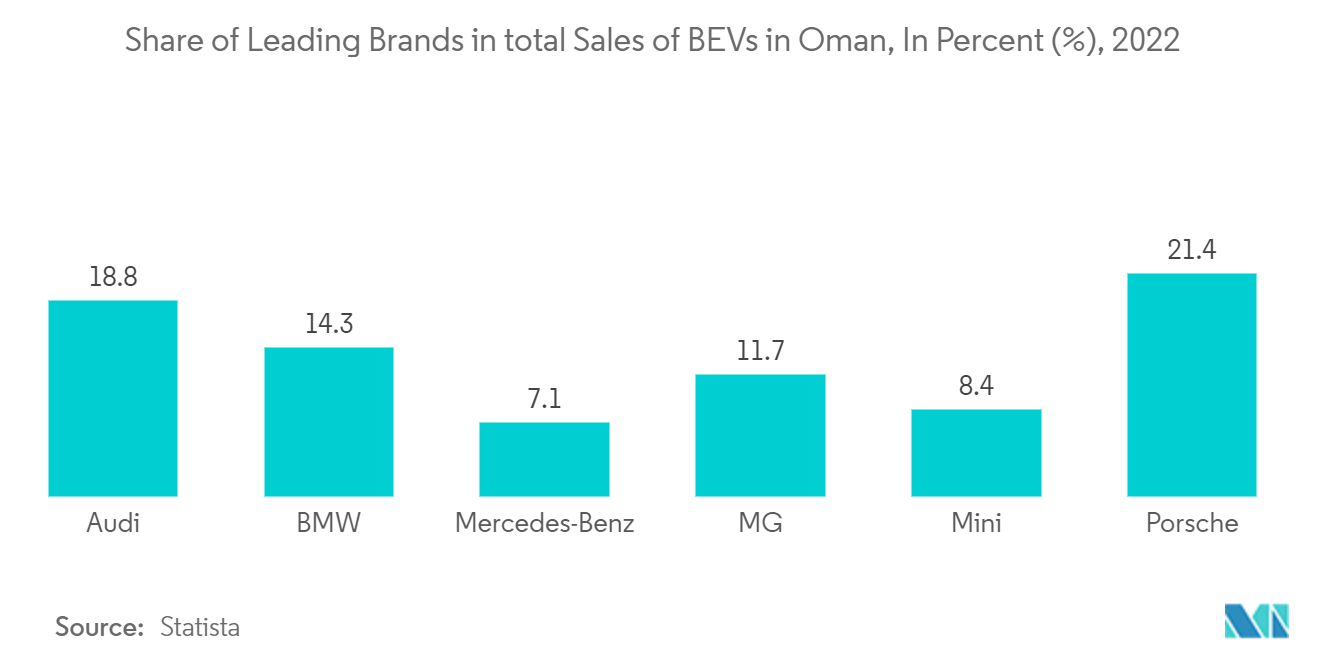
The HEV Segment is the Most Prevalent Propulsion Type in Oman
Oman, Hybrid Electric Vehicles (HEVs) are emerging as a leading segment within the broader electric vehicle (EV) market owing to several factors like range and fuel efficiency, consumer acceptance, and increasing government support.
HEVs combine an internal combustion engine (ICE) with an electric motor and battery pack, offering improved fuel efficiency compared to traditional gasoline-powered vehicles. In Oman, where long distances between cities and limited charging infrastructure pose challenges for fully electric vehicles (EVs), HEVs provide a practical solution by offering extended range and reducing the need for frequent refueling.
Further, the Omani government's initiatives to promote sustainable transportation and reduce carbon emissions include incentives and subsidies for hybrid vehicles. These incentives make HEVs more affordable and attractive to consumers, further driving their adoption and market leadership in Oman.
The Ministry of Transport, Communications, and Information Technology (MTCIT) offers a 100 percent exemption from customs tax for electric vehicles, exemption from registration fees at the Royal Oman Police (ROP), and a zero percent VAT for vehicles and their spare parts.
Moreover, HEVs serve as a transitional technology for consumers who are not yet ready to fully commit to all-electric vehicles but still want to reduce their carbon footprint and fuel expenses. By offering a blend of conventional and electric powertrains, HEVs provide a practical and accessible entry point into the world of electric mobility, allowing consumers to experience the benefits of electrification without the range limitations or charging infrastructure requirements of fully electric vehicles.
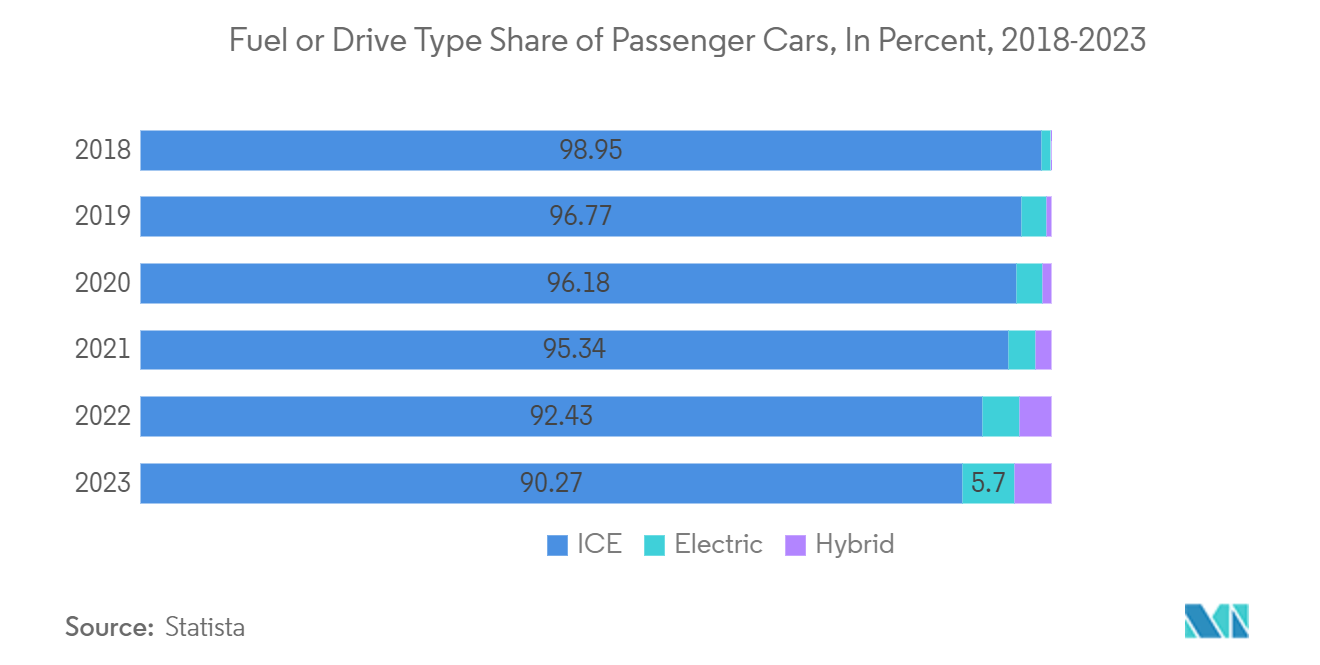
Oman EV Industry Overview
The Omani EV market is highly consolidated, with a few players holding more than 70% of the market share. The key market players are Porsche, Audi, Volvo, MG, and BMW. These players offer innovative and updated products to stay ahead of their competitors.
- September 2023: The Oman Investment Authority invested in US-based electric vehicle battery start-up Our Next Energy (One) to ensure the growth of the country's electric car market.
Oman EV Market Leaders
-
Porche
-
Audi
-
BMW
-
Volvo
-
MG
*Disclaimer: Major Players sorted in no particular order
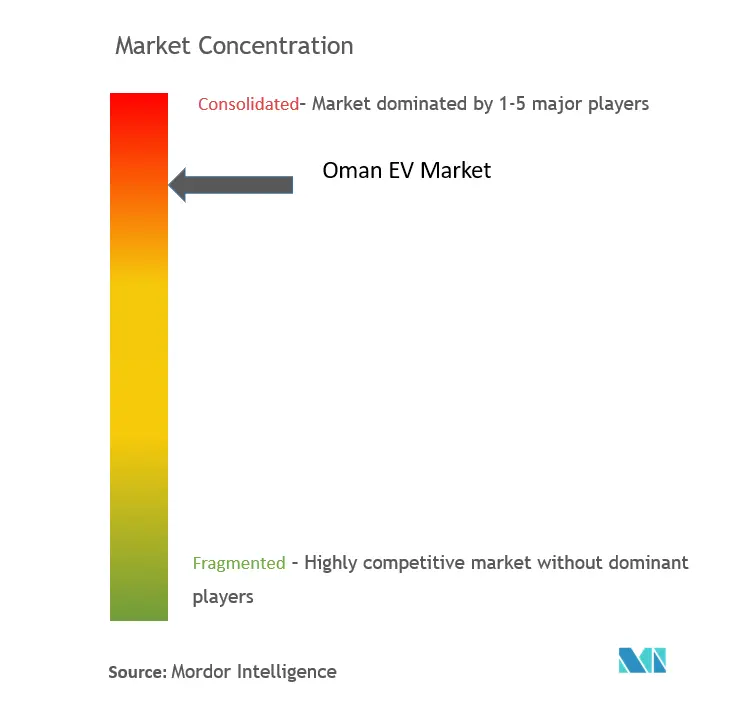
Oman EV Market News
- March 2024: Bahwan Automobiles and Trading LLC (BAT) announced a partnership with India’s JBM Electric Vehicles (P) Ltd. to introduce a new portfolio of electric buses in Oman. The agreement was signed at the MENA Transport Congress & Exhibition 2024 in Dubai. The collaboration marks BAT’s strategic expansion into the electric vehicle (EV) market and JBM’s entry into the MEA region.
- February 2024: VinFast Auto signed a dealer sales agreement with Bahwan Automobiles Trading LLC (BAT) for the distribution of electric vehicles in the Sultanate of Oman. This signifies VinFasts initial operation in the Middle East region and also a significant step in VinFast’s global expansion. As per the agreement, from 2024 to 2027, BAT plans to establish and operate 13 VinFast stores and service centers. The inaugural store is anticipated to open in mid-2024. Additionally, VinFast will collaborate with BAT to sell four e-SUV models: VF 6, VF 7, VF 8, and VF 9 upon the completion of their market launch.
- July 2023: Oman Oil Marketing Company (OOMCO) announced a partnership with Synergy Investment LLC to establish Electric Vehicles One (EVO), which will be tasked with developing Oman’s electric vehicle infrastructure. The agreement was signed on July 3, 2023.
Oman EV Market Report - Table of Contents
1. INTRODUCTION
- 1.1 Study Assumptions
- 1.2 Scope of the Study
2. RESEARCH METHODOLOGY
3. EXECUTIVE SUMMARY
4. MARKET DYNAMICS
-
4.1 Market Drivers
- 4.1.1 The Growing Emphasis on Sustainable Fuels is Driving the Market
-
4.2 Market Challenges
- 4.2.1 High Initial Investment is a Challenge
-
4.3 Porters Five Forces Analysis
- 4.3.1 Threat of New Entrants
- 4.3.2 Bargaining Power of Buyers/Consumers
- 4.3.3 Bargaining Power of Suppliers
- 4.3.4 Threat of Substitute Products
- 4.3.5 Intensity of Competitive Rivalry
5. MARKET SEGMENTATION (Market Size in Value USD)
-
5.1 Vehicle Type
- 5.1.1 Two-wheeler
- 5.1.2 Passenger Car
- 5.1.3 Commercial Vehicle
-
5.2 Propulsion Type
- 5.2.1 Battery Electric Vehicle (BEV)
- 5.2.2 Hybrid Electric Vehicle (HEV)
- 5.2.3 Plug-In Hybrid Electric Vehicle (PHEV)
-
5.3 Battery Type
- 5.3.1 Lithium Iron Phosphate Battery (LFP)
- 5.3.2 Nickel Manganese Cobalt (NMC)
- 5.3.3 Other Battery Types
-
5.4 Range
- 5.4.1 Upto 150 km
- 5.4.2 151-300 km
- 5.4.3 Above 300 km
-
5.5 Drive Type
- 5.5.1 All-wheel Drive
- 5.5.2 Front-wheel Drive
- 5.5.3 Rear-wheel Drive
-
5.6 Battery Capacity
- 5.6.1 Less than 20 kWh
- 5.6.2 20-40 kWh
- 5.6.3 40-60 kWh
- 5.6.4 60-100 kWh
- 5.6.5 Above 100 kWh
-
5.7 End-User
- 5.7.1 Shared Mobility Providers
- 5.7.2 Government Organizations
- 5.7.3 Personal Users
6. COMPETITIVE LANDSCAPE
- 6.1 Vendor Market Share
-
6.2 Company Profiles
- 6.2.1 Audi AG
- 6.2.2 Bayerische Motoren Werke AG
- 6.2.3 Toyota Group
- 6.2.4 Porche AG
- 6.2.5 Geely Holding Group
- 6.2.6 Mercedes-Benz AG
- 6.2.7 Chevrolet
- 6.2.8 Mazda
- 6.2.9 Tata Group
- 6.2.10 Volvo Group
- *List Not Exhaustive
7. MARKET OPPORTUNITIES AND FUTURE TRENDS
- 7.1 Development of Wireless EV Charging Technology for On-the-Go Charging
- 7.2 Increasing Demand for Electric Vehicles in the Transportation Sector
8. MARKET SIZE AND FORECAST IN TERMS OF VOLUME
9. AN INSIGHT INTO THE REGULATORY FRAMEWORK REGARDING VEHICLE EMISSION IN THE COUNTRY
** Subject To AvailablityOman EV Industry Segmentation
An electric vehicle (EV) is a vehicle powered primarily by electricity. The electricity required is stored in rechargeable batteries. In some models, it is supplied by an external source, such as a plug-in charger. EVs are considered ideal as they produce zero tailpipe emissions and offer a sustainable alternative to traditional ICE vehicles.
The Omani EV market is segmented by vehicle type, propulsion type, battery type, range, drive type, battery capacity, and end user. By vehicle type, the market is segmented into two-wheel, passenger car, and commercial vehicle. By propulsion type, the market is segmented into battery electric vehicles (BEV), hybrid electric vehicles (HEV), and plug-in hybrid electric vehicles (PHEV). By battery type, the market is segmented into LFP, NMC, and other battery types. By range, the market is segmented as upto 150 km, 151-300 km, and above 300 km. By drive type, the market is segmented as all-wheel drive, front-wheel drive, and rear-wheel drive. By battery capacity, the market is segmented as less than 20 kwh, 20-40 kwh, 40-60 kwh, 60-100 kwh, and above 100 kwh. By end user, the market is segmented as shared mobility providers, government organizations, and personal users. The report offers market size and forecast in value (USD) for all the above segments.
| Vehicle Type | Two-wheeler |
| Passenger Car | |
| Commercial Vehicle | |
| Propulsion Type | Battery Electric Vehicle (BEV) |
| Hybrid Electric Vehicle (HEV) | |
| Plug-In Hybrid Electric Vehicle (PHEV) | |
| Battery Type | Lithium Iron Phosphate Battery (LFP) |
| Nickel Manganese Cobalt (NMC) | |
| Other Battery Types | |
| Range | Upto 150 km |
| 151-300 km | |
| Above 300 km | |
| Drive Type | All-wheel Drive |
| Front-wheel Drive | |
| Rear-wheel Drive | |
| Battery Capacity | Less than 20 kWh |
| 20-40 kWh | |
| 40-60 kWh | |
| 60-100 kWh | |
| Above 100 kWh | |
| End-User | Shared Mobility Providers |
| Government Organizations | |
| Personal Users |
Oman EV Market Research FAQs
How big is the Oman EV Market?
The Oman EV Market size is expected to reach USD 214.45 million in 2024 and grow at a CAGR of 30.33% to reach USD 805.32 million by 2029.
What is the current Oman EV Market size?
In 2024, the Oman EV Market size is expected to reach USD 214.45 million.
Who are the key players in Oman EV Market?
Porche, Audi, BMW, Volvo and MG are the major companies operating in the Oman EV Market.
What years does this Oman EV Market cover, and what was the market size in 2023?
In 2023, the Oman EV Market size was estimated at USD 149.41 million. The report covers the Oman EV Market historical market size for years: 2019, 2020, 2021, 2022 and 2023. The report also forecasts the Oman EV Market size for years: 2024, 2025, 2026, 2027, 2028 and 2029.
Oman EV Industry Report
Statistics for the 2024 Oman EV market share, size and revenue growth rate, created by Mordor Intelligence™ Industry Reports. Oman EV analysis includes a market forecast outlook for 2024 to to2029 and historical overview. Get a sample of this industry analysis as a free report PDF download.



